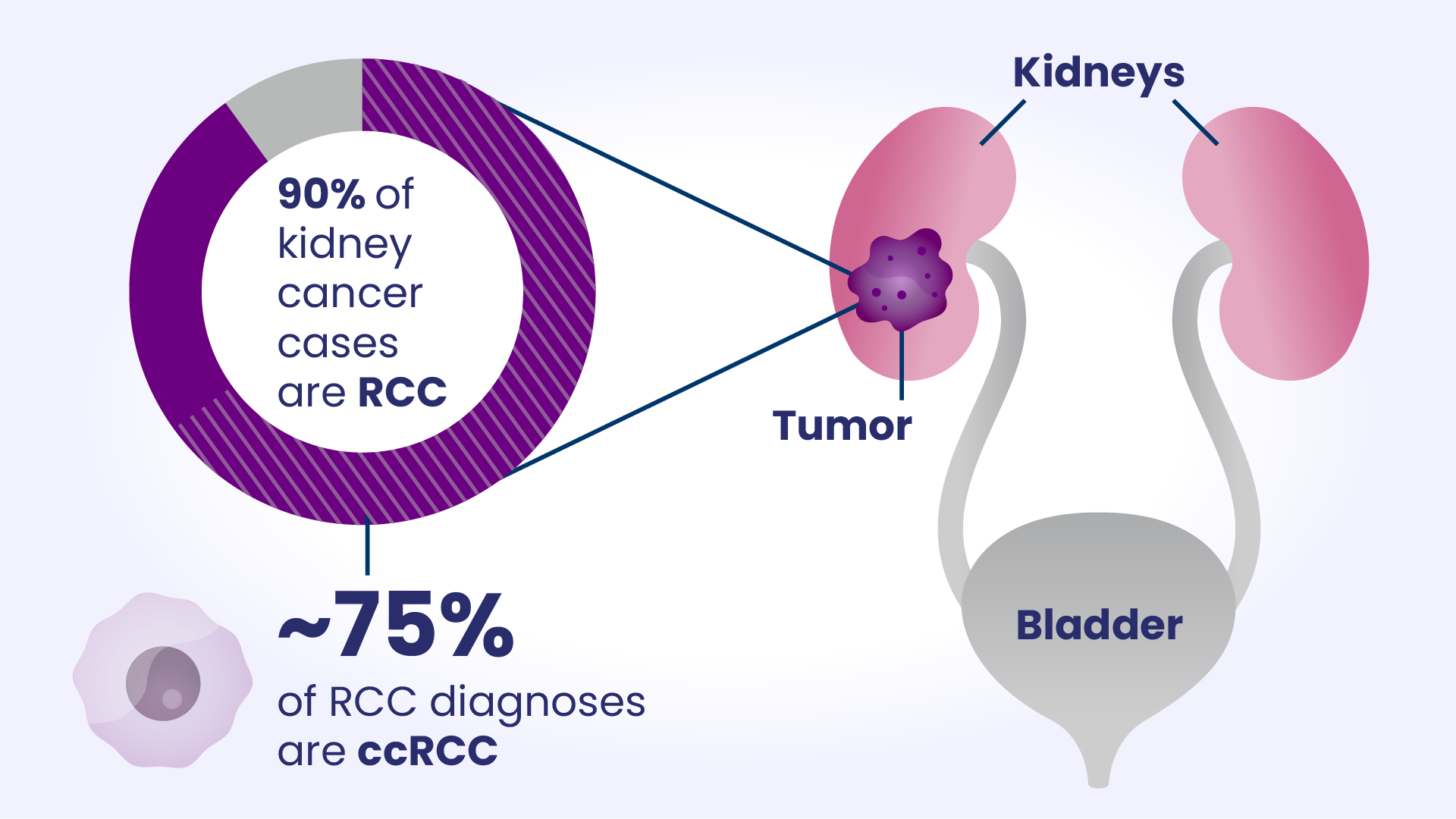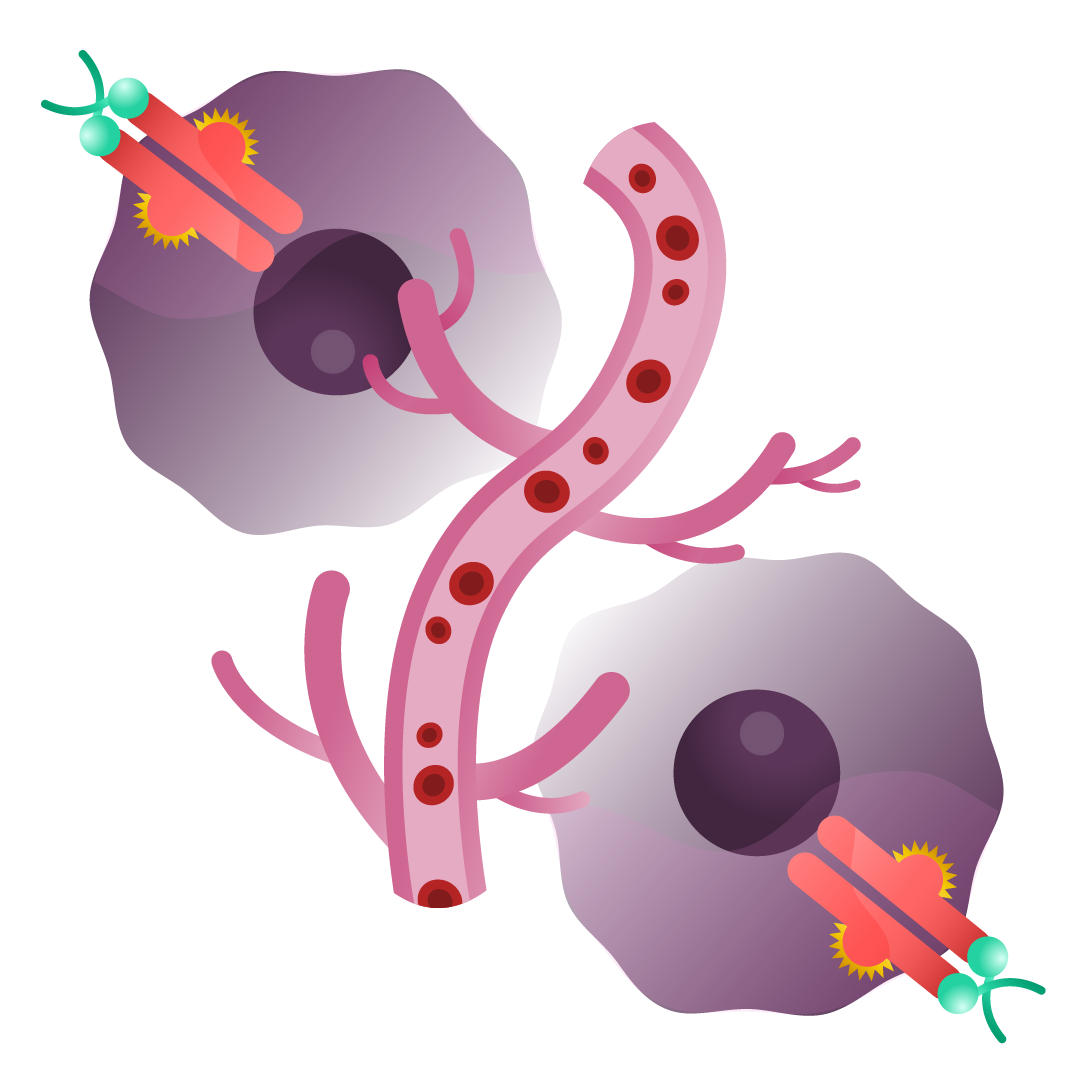





Combining for Change in Kidney Cancer
Like many busy moms, Leah is used to juggling her work with her kids’ school schedules and activities. To manage it all, she became an expert at planning and preparing for the unexpected. But even she couldn’t prepare for what occurred during her last pregnancy: a kidney cancer diagnosis.
Leah is one of approximately 600,000 people in the U.S. who have been diagnosed with kidney cancer.1 While there has been substantial progress in treatment in recent years, even more innovative approaches are needed to improve survival, especially when the cancer is metastatic, meaning it has spread to other parts of the body.
Kidney Cancer Basics
The kidneys are a hard-working pair of organs that sit above the bladder and filter the blood to remove extra water, salt and waste products.2 Kidney cancer occurs when cells in the kidney grow out of control, which can cause the organ to stop functioning normally.2

People with kidney cancer may experience a range of symptoms such as lower back pain, fever, fatigue, loss of appetite and weight loss, all of which can be debilitating.4 Beyond the physical symptoms, people may also experience other impacts to their daily life, including sleep disturbances and mental health or mood challenges like worry and irritability.5,6
In the U.S., kidney cancer is one of the 10 most common cancers, and the number of people diagnosed with this disease has been increasing for many years.7 Fortunately, as new treatment options for kidney cancer have become available, more people have the opportunity to live longer.7 Still, the outlook continues to be extremely challenging for those with metastatic disease: the average 5-year survival rate is only 18% for advanced disease compared to 93% for those with localized cancer.8
Novel treatment approaches are needed to help improve these numbers for people living with the metastatic form of this disease.
Evolving Treatment for Metastatic Kidney Cancer
Treatment for metastatic kidney cancer has progressed substantially in recent decades, but for many people, existing treatment options can stop working, potentially allowing the cancer to return.9
One promising approach is to combine multiple treatments that simultaneously address distinct biological pathways contributing to cancer cell growth. Some of the proteins that can be targeted in key kidney cancer pathways include:

HIF-2⍺:
A protein that promotes tumor growth when oxygen levels are low or when certain cancer cells mimic low oxygen levels.10 It plays a role in processes like angiogenesis (growth of new blood vessels that feed tumors) and cell proliferation.10

Tyrosine Kinases (TKs):
Proteins that can be overactive, promoting excessive cell growth and survival, as well as angiogenesis.11,12 In some cases, HIF-2α can collaborate with TKs and cause cells to grow out of control.13

Immune checkpoint proteins: Proteins that stop the immune system from recognizing and destroying cancer cells.14
At Arcus, our approach is rooted in combinations, because we believe they have the most potential to meaningfully advance treatment options for people living with metastatic kidney cancer. A critical part of this strategy is to limit the possible adverse events for each individual investigational medicine so that combination treatments will target the disease pathways without creating unmanageable side effects.
Clinical trials are underway to assess different combination approaches in metastatic kidney cancer and their potential to provide people with novel treatment options.
Moving Forward with Kidney Cancer
While a kidney cancer diagnosis can be overwhelming, for Leah, it changed her perspective on life. It allowed her to find beauty in the uncertainty. Today, she’s gotten to continue seeing her family through important milestones. And she’s using her experiences to work as a kidney cancer advocate to push for more kidney cancer research funding, with the goal of moving the treatment landscape forward.
To learn more about Leah and see the one-of-a-kind artwork depicting her story, visit the PortrAIts of Cancer™ gallery.
References:
1. “Cancer Stat Facts: Kidney and Renal Pelvis Cancer.” National Cancer Institute, Surveillance Epidemilogy, and End Results Program. Accessed February 2025. https://seer.cancer.gov/statfacts/html/kidrp.html
2. “What is Kidney Cancer?” American Cancer Society. Accessed February 2025. https://www.cancer.org/cancer/types/kidney-cancer/about/what-is-kidney-cancer.html
3. Chen, Liuyan, et al. “Clinical significance and pro-oncogenic function of DBF4 in clear cell renal cell carcinoma.” BMC urology. 25.1 (2025): 8.
4. “Kidney Cancer Signs and Symptoms.” American Cancer Society. Accessed February 2025. https://www.cancer.org/cancer/types/kidney-cancer/detection-diagnosis-staging/signs-and-symptoms.html
5. Harding, Gale, et al. “Symptom burden among patients with renal cell carcinoma (RCC): content for a symptom index.” Health and Quality of Life Outcomes. 5 (2007): 1-12.
6. Demirtaş, Türev, and Zekeriya Temircan. “Examining the relationship between depression, anxiety and stress in kidney cancer patients.” Journal of Kidney Cancer and VHL. 9.1 (2021): 19.
7. “Key Statistics About Kidney Cancer.” American Cancer Society. Accessed February 2025. https://www.cancer.org/cancer/types/kidney-cancer/about/key-statistics.html
8. “Survival Rates for Kidney Cancer.” American Cancer Society. Accessed February 2025. https://www.cancer.org/cancer/types/kidney-cancer/detection-diagnosis-staging/survival-rates.html
9. Cardenas, Luisa M., et al. “Advances in the management of renal cell carcinoma.” CMAJ. 196.7 (2024): E235-E240.
10. Cuvillier, Olivier. “The therapeutic potential of HIF-2 antagonism in renal cell carcinoma.” Translational andrology and urology. 6.1 (2017): 131.
11. Du, Zhenfang, and Christine M. Lovly. “Mechanisms of receptor tyrosine kinase activation in cancer.” Molecular cancer. 17 (2018): 1-13.
12. Yang, Yang, et al. “Protein tyrosine kinase inhibitor resistance in malignant tumors: molecular mechanisms and future perspective.” Signal transduction and targeted therapy. 7.1 (2022): 329.
13. Mazumder, Sonia, Paul J. Higgins, and Rohan Samarakoon. “Downstream targets of VHL/HIF-α signaling in renal clear cell carcinoma progression: mechanisms and therapeutic relevance.” Cancers. 15.4 (2023): 1316.
14. He, Xing, and Chenqi Xu. “Immune checkpoint signaling and cancer immunotherapy.” Cell research. 30.8 (2020): 660-669.
RECENT ARTICLES
From Paper to Pill
There is opportunity to develop new and potentially improved molecules that block HIF-2α to further improve outcomes.
Addressing Adenosine: Immunotherapy in the Tumor Microenvironment
Targeting the adenosine axis – components that contribute to the production of adenosine and its subsequent impact – is a promising option.
